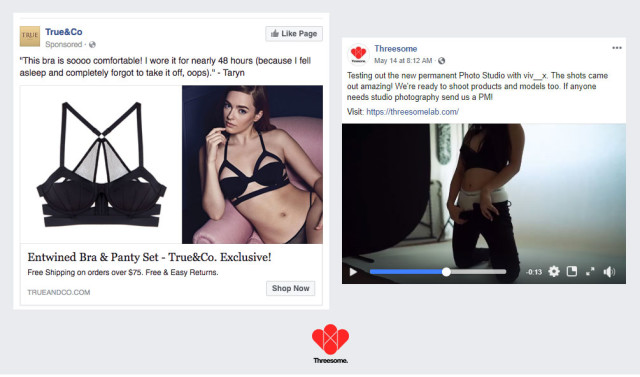I often write opinion pieces in order to get shit off my chest. Recently I boosted a video post of us (Threesome) launching our new photo studio and Facebook denied the boost. I wasn’t so upset as I’m sure facebook has flagged anything I post, but Dianne was upset enough to write a rant about it, and I fucking love her rant! I had no idea she could write SO WELL. I love her writing style. Read up:
Where’s the thin white line?
Today, we are bombarded with images that are hypersexualised in nature. It’s everywhere. Walk along the street and you’ll see an ad with a model selling skimpy underwear, a pouty set of lips with bright red lipstick with a suggestive tongue or finger to sell makeup, heck, even guys are not immune to being sexualised with rock hard abs of steel the must have in any jeans ad.
Sex sells. No doubt about it.
We are living in a time when it’s everywhere and it’s impossible to avoid unless you were to pack up and live as a hermit in the desert.
There’s nothing wrong with it – it’s just a sign of the times. There is and always will be an ever present thin white line between what is considered okay to be seen and what is considered too lewd.
A quick search of Australia’s Ad Standards cases with the keyword “sex” brings up a myriad of cases, but the number of cases that are dismissed by the panel far outweigh the cases upheld. In other words, the majority of the complaints that are made by members of the public taking an issue with something simply because they themselves find it offensive.
There’s nothing wrong with this either. What one person finds offensive is subjective. That’s why there is the Ad Standards avenue for people to get their complaints reviewed.
Where there is an issue is when social media companies like Facebook, Instagram, Twitter et cetera – who owe their success to their audience utilising their platforms and businesses that use their platform to advertise – start preempting issues.
In response to complaints they make the decision to bow down to the lowest common denominator and the thin white line gets moved as far right as possible. Their reasoning becomes that of “why risk any complaints at all” is problematic because in doing so they make the decision for us of what is acceptable.
In the most extreme, some may argue that they have taken onto themselves to limit free speech and dictate to their audience what content they see.
Sure, it’s their platform, their rules – but where does it stop? Who decides what is ‘okay’ and what isn’t?
We recently went afoul of these rules when we attempted to promote a video of a recent model shoot in our studio from our Facebook page only to have it rejected because “We don’t allow ads with content that features sexually suggestive positioning or that shows a lot of skin (even if it’s for an artistic or education reason) because of their highly sensitive nature.”
Really? Below is an ad that has been taken from Facebook and a screenshot what is probably (but hardly) the most “suggestive” part of the video. Why is a lingerie ad with a model showing plenty of skin acceptable whereas a video showing a studio shoot with model showing a tiny bit of midriff not?
Unfortunately there is nothing you can do about it. You can request a ‘review’ but all you get back is a bot generated generic response identical to the rejection.
Again, their platform, their rules and if we (as small businesses) want to continue using it as a tool to reach potential customers then we have to comply. However, it is our choice to use their platform.
With the direction that Facebook is going in there are already companies that are making the move to leave for a myriad of reasons – whether it be a reaction to the Cambridge Analytica privacy scandal or their bait and switch tactic of giving a business free access to their followers before pulling this and putting out their hands for money to continue reaching them. Those in themselves are huge issues, but that’s a whole other Pandora’s box to deal with.

